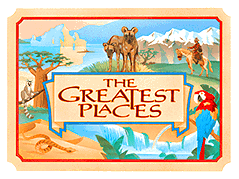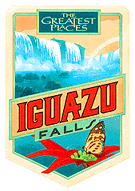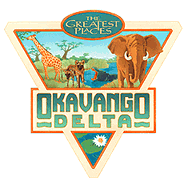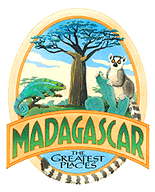Your Passport to the World's Greatest Places

Find clues in museum exhibits to connect our "greatest place", the Science Museum of
Minnesota, with our Omnifilm, The Greatest Places.
Gallery names are in bold. Exhibit names are italicized.
- Find the seven Greatest Places on the large map in Paleontology East Building/Ground
Floor.
( Madagascar, Chang Tang (Tibetan Plateau), Amazon Basin, Iguazu Falls, Namib Desert,
Greenland, Okavango Delta)
 Greatest Places fact: Iguazu Falls, on the border of Brazil and Argentina, is made
up of 275 separate waterfalls.
Greatest Places fact: Iguazu Falls, on the border of Brazil and Argentina, is made
up of 275 separate waterfalls.
For some clues, check out the big water and clay sculpture in the middle of Our
Minnesota, Canyon,
Lake
Desert,
Delta.
- Can you find more than one waterfall? How many?
- What happens at the bottom of the waterfall?
- Watch carefully when the water stops flowing.
- Do you know of some other famous waterfalls?
 Greatest Places fact: The Tibetan Plateau ( Chang
Tang ), the highest large plateau in the world, has few shrubs
or trees. People living here use the yak for many things,
including food, shelter, and clothing.
Greatest Places fact: The Tibetan Plateau ( Chang
Tang ), the highest large plateau in the world, has few shrubs
or trees. People living here use the yak for many things,
including food, shelter, and clothing.
Anthropology West Building, second floor
- Find examples of animals that other people in the world have used for food, clothing
and shelter or other uses.
 Greatest Places fact: The Okavango Delta is the world's largest inland delta. Its
permanent swamps and variety of habitats are home to
elephants, crocodiles, hippos, antelope, lions, wild dogs, a
multitude of birds and almost 80 species of fish.
Greatest Places fact: The Okavango Delta is the world's largest inland delta. Its
permanent swamps and variety of habitats are home to
elephants, crocodiles, hippos, antelope, lions, wild dogs, a
multitude of birds and almost 80 species of fish.
Our Minnesota East Building, second floor
Look for any deltas in the water/clay sculpture, named Canyon, Lake Desert, Delta.
( A delta is named after the Greek letter which is the shape of a triangle )
- How is a delta formed?
- Try to form a delta on the Stream Table prototype.
- Where do deltas usually occur?
- Why?
 Greatest Places fact: Madagascar, an island ark off the east coast of Africa,
contains semi-arid, temperate and tropical climates. As many
as 10,000 species of plants live in Madagascar ( Minnesota
has about 2000 )
Greatest Places fact: Madagascar, an island ark off the east coast of Africa,
contains semi-arid, temperate and tropical climates. As many
as 10,000 species of plants live in Madagascar ( Minnesota
has about 2000 )
Paleontology East Building, ground floor
- Minnesota was once on the equator! What kind of climate did Minnesota have then? (
Find clues in the exhibits behind the big map. )
- As the earth changed over time, the land, water and life in this place changed. What
is Minnesota's climate like today?
- Lemurs are found only in Madagascar. Do you know of any plants or animals that are
found only in Minnesota?
 Greatest Places fact: The Namib Desert, along the west coast of Africa has some of
the tallest dunes in the world. They may reach 350 meters.
Greatest Places fact: The Namib Desert, along the west coast of Africa has some of
the tallest dunes in the world. They may reach 350 meters.
Experiment Gallery, West Building, third floor
Constant wind in the desert forms dunes. Find the Aeolian Landscape.
- Can you form a very tall dune in this exhibit?
- Predict what will happen to this dune when you shift the wind direction.
- Use the round handle to change the direction of the wind ( fan ). How does the result
match your prediction?
- Can you make the dunes migrate as in the Namib Desert?
- Can you think of any deserts in the US?
 Greatest Places fact: The Amazon River receives the water of more than 1000 other
rivers. One of these tributaries , the Rio Negro, is named for
the dark waters stained by acid. ( Negro is Spanish for
black )
Greatest Places fact: The Amazon River receives the water of more than 1000 other
rivers. One of these tributaries , the Rio Negro, is named for
the dark waters stained by acid. ( Negro is Spanish for
black )
Our Minnesota East Building, second floor
- When two rivers meet, do they look the same or different?
There are three photographs in Our Minnesota that can help answer this question.
Choose one or look at all three. In each case, two rivers join together.
Title: Where Two Rivers Meet ( near the handheld plow )
Title: Window
on the
St.
Croix
River-
Mixing
Rivers
Title: Green Street ( large wall map of the Twin Cities )
- What are the rivers shown? 1.____________________
2.____________________ 3.____________________
- How are the two rivers different in each photograph?
- What color is the river closest to where you live?
 Greatest Places fact: Greenland has the second largest ice cap in the world. 85% of
Greenland is covered by ice.
Greatest Places fact: Greenland has the second largest ice cap in the world. 85% of
Greenland is covered by ice.
Experiment Gallery West Building, third floor
Look at the exhibits about the sun's energy in the Weather section. Which exhibits
give you clues about the formation of snow, ice caps or the amount of the sun's energy
that reaches the earth? ( Look at all these exhibits to answer the questions below )
- Where is Greenland located on the earth?
- Summer Sun/Winter Sun allows you to change the angle of "sunlight".
- What happens to the amount of the sun's energy when you make the angle bigger?
- Would Greenland receive more or less energy than Minnesota?
- Why don't we have ice caps in Minnesota?
Provided by School Services,
Science Museum of Minnesota
© 1999
|